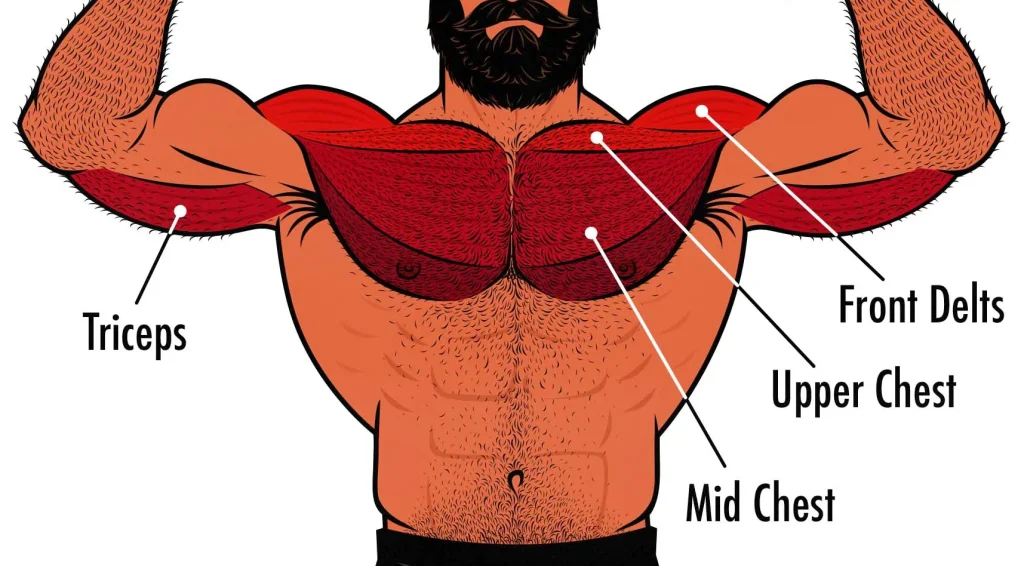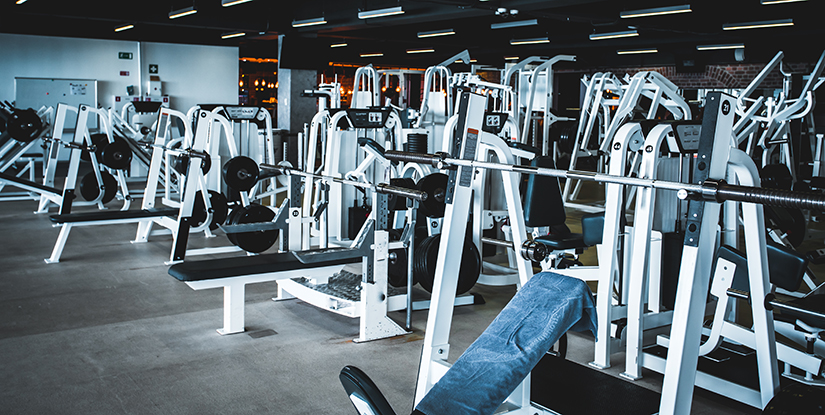What angle for incline bench — ever really thought about it?
Most people don’t. You just walk in, throw the bench up a bit, maybe to 45°, and start pressing. Feels fine, right?
But here’s the thing: that little angle? It changes everything.
Too high, and suddenly it’s all shoulders. Too low, and you might as well be doing a flat bench.
If you’re trying to hit your upper chest, the angle matters. A lot.
So let’s break it down real simple — what works, what doesn’t, and how to stop wasting reps on the wrong setup.
How Incline Bench Really Works
Incline Bench Press mainly works your upper chest — but only if you set it up right.
We just talked about how the angle affects everything. So before you crank that bench up to 45°, let’s break down what’s actually going on. These are the 3 things you really need to know.
🔹 What muscles does incline bench press work?

The target is your upper chest — that top area just under your collarbone. But it’s not doing all the work by itself.
- Main muscle: Upper chest (clavicular head of your pecs)
- Support muscles: Front delts (shoulders) and triceps
- What often goes wrong: Too much incline = your shoulders take over
- Why this matters: If your goal is chest growth, but you feel it more in your shoulders, you’re probably at the wrong angle
🔹 Why does changing the angle change everything?
Because the angle changes your pressing path — and that shifts where the tension goes.
- Higher angle → more vertical push → more shoulder work
- Lower angle → more chest-focused movement
- Even small shifts matter: 30° vs 45° can feel totally different
- How to spot it:
- If the bar feels like it’s moving toward your face → angle’s too steep
- If it drops toward your mid/lower chest → too flat
- If the bar feels like it’s moving toward your face → angle’s too steep
🔹 What angle for incline bench press usually offer?
Most benches can do a wide range — but that doesn’t mean they’re always right for the chest.
- Typical range: 15° to 60°
- Best range for chest work: 30° to 45°
- Over 45°: You’re in shoulder press territory
- What most people do wrong: Eyeball it, end up too high
- Quick tip: Use a phone angle app, or memorize which notch feels right for you
How Different Incline Angles Affect Training
The bench angle you choose decides which muscle does the work.
Tilt it too high? Shoulders take over. Too low? Chest barely feels it.
Not all incline angles hit the same.
30°, 45°, 60° — they all feel different. Let’s figure out which one actually works for what you want.

🟦 30° Incline – Best for Chest Isolation
If you’re wondering what angle is best for incline bench, this is it. 30° hits the upper chest directly while keeping shoulder involvement low. The movement feels strong and controlled — just right.
Muscle Activation: Upper chest takes the lead; minimal shoulder support
Best For: Chest growth, definition, and better muscle engagement
Use With: Dumbbells for stretch and control, or barbell for heavier sets
⚠️ Quick Tip: Use a phone angle app if your bench isn’t labeled
🟦 45° Incline – Chest + Shoulders Combo
At 45°, the press becomes steeper. Your chest still works, but your front delts join in a lot more. It’s a hybrid feel — not bad, just less focused.
Muscle Activation: Upper chest + front delts share the load
Best For: General upper-body strength or variation
Use With: Barbell, Smith machine, or incline barbell press machine
⚠️ Watch Out: Rushing reps can shift tension away from your chest
🟦 60° Incline – Mostly Shoulders
This is where incline becomes shoulder press. The movement feels more vertical, and chest activation drops way off. A lot of people use this angle by accident.
Muscle Activation: Front delts dominate; chest barely involved
Best For: Shoulder days, not chest-focused sessions
Use With: Dumbbells or overhead press machines
⚠️ Mistake Alert: Too steep = chest misses the work
👉 Quick Recap:
30° = chest gains
45° = shared effort
60° = shoulder territory
How to Choose the Right Incline Angle for You
Not sure what angle for incline bench?
Here’s the thing — it depends on what you’re trying to do.
Different goals, different angles. Simple as that.
| If You Want To... | Go With | Because |
|---|---|---|
| Grow your upper chest (more shape) | 30° | Direct chest tension, less shoulder takeover |
| Push heavier weight (more power) | 35°–45° | Shoulders assist more = better leverage + force output |
| Focus on shoulders (on purpose) | 60°+ | Chest checks out — delts do most of the work |
👉 What If Your Bench Isn’t Adjustable?
No problem.
- Use your phone’s angle app — set it somewhere between 25°–40°
- No app? Go by feel. If your shoulders burn but chest doesn’t, your angle’s probably too steep
- A slight tilt is enough — don’t go vertical unless you want shoulders
Common Mistakes and Training Tips
Some people mess up incline bench without even knowing it. Here’s what to avoid — and how to fix it.

❌ Using angles that are way too steep
Once you go past 50°, you’re not pressing for chest anymore — you’re basically doing a shoulder day. Nothing wrong with that… unless your goal was upper chest.
❌ Sticking to one angle forever
Your body adapts fast. If you’ve been pressing at 45° every single week? Your chest probably stopped responding weeks ago. Mix it up.
❌ Ignoring setup and control
No matter the angle, if your shoulders are shrugged up, your scapula isn’t set, and you’re bouncing the weight — the angle won’t save you.
✅ Quick training tips
- Start with 30° if unsure — safest for chest
- Change angles every few weeks to keep results coming
- Focus on how it feels, not just what the bench says
Incline bench isn’t just “chest on a slant.”
The angle you pick changes everything — where the tension goes, how it feels, and what grows.
There’s no magic number, but here’s the truth:
30° works for most. 45° works for some. 60° works if you’re hitting shoulders.
Try different setups. Pay attention to what your chest actually feels.
Forget what the weight bench says — trust what your body tells you.
Now go press something.

Hi, I’m Alex Carter, part of the editorial team at Leadman Fitness. We specialize in crafting premium custom racks, cable machines, functional trainers, and strength accessories for home and commercial gyms. With a background in competitive powerlifting and gym design consulting, I’ve spent years testing gear under heavy loads and optimizing layouts for efficiency.
I focus on translating real-world user frustrations—like space limitations, budget constraints, or durability needs—into actionable solutions. By collaborating directly with our engineers and facility owners, I ensure our custom equipment evolves to solve the unspoken challenges lifters face daily. What I share isn’t textbook advice; it’s battle-tested insight from racks I’ve welded, cables I’ve replaced, and gym floors I’ve trained on.
